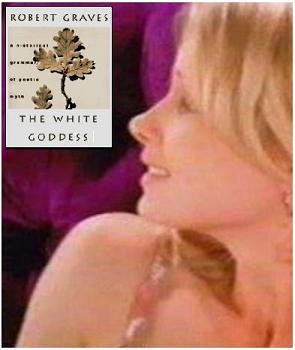
Monday, August 17, 2020
On Set: Creamy and Sweaty
Saturday, March 16, 2024
Saturday Evening Word
The word "creamy" in this journal suggests a look at . . .
Monday, January 25, 2021
Illuminations
For the title, see Illuminations in this journal.
Another approach —

![]()

These images were suggested by Creamy and Sweaty.

Monday, September 14, 2020
Classics Illustrated

“You’re reading me,” she murmurs.
“Particularly and surprisingly well-preserved;
tight, bright, clean and especially sharp-cornered.”
Update of 7 PM ET Sept. 14, 2020 —
A sequel to Creamy and Sweaty —

“Stop loading this page.” . . . “Too late.”
Saturday, September 8, 2007
Saturday September 8, 2007
The Intensest Rendezvous
"There is one story and one story only
That will prove worth your telling….
Dwell on her graciousness, dwell on her smiling,
Do not forget what flowers
The great boar trampled down in ivy time.
Her brow was creamy as the crested wave,
Her sea-blue eyes were wild
But nothing promised that is not performed. "
— Robert Graves,
To Juan at the Winter Solstice
The Devil and Wallace Stevens:
"In a letter to Harriet Monroe, written December 23, 1926, Stevens refers to the Sapphic fragment that invokes the genius of evening: 'Evening star that bringest back all that lightsome Dawn hath scattered afar, thou bringest the sheep, thou bringest the goat, thou bringest the child home to the mother.' Christmas, writes Stevens, 'is like Sappho's evening: it brings us all home to the fold.' (Letters of Wallace Stevens, 248)"
— "The Archangel of Evening," Chapter 5 of Wallace Stevens: The Intensest Rendezvous, by Barbara M. Fisher, The University Press of Virginia, 1990, pages 72-73
"Evening. Evening of this day. Evening of the century. Evening of my own life….
At Christmastime my parents held open house on Sunday evenings, and a dozen or more people gathered around the piano, and the apartment was full of music, and theology was sung into my heart."
— Madeleine L'Engle, Bright Evening Star: Mystery of the Incarnation
From the date of
L'Engle's death:

Some enchanted evening…
Wednesday, December 21, 2005
Wednesday December 21, 2005
| To Graves at the Winter Solstice
“There is one story and one story only Dwell on her graciousness, dwell on her smiling, — Robert Graves,   |
Thursday, June 30, 2005
Thursday June 30, 2005
In 1936, Gone with the Wind
was published.
In 1971, Monica Potter
was born.

Sources:
Amazon.com and
Tall Tall Trees
That will prove worth your telling,
Whether as learned bard or gifted child;
To it all lines or lesser gauds belong
That startle with their shining
Such common stories as they stray into.
Is it of trees you tell, their months and virtues,
Or strange beasts that beset you,
Of birds that croak at you the Triple will?
Or of the Zodiac and how slow it turns
Below the Boreal Crown,
Prison to all true kings that ever reigned?
Water to water, ark again to ark,
From woman back to woman:
So each new victim treads unfalteringly
The never altered circuit of his fate,
Bringing twelve peers as witness
Both to his starry rise and starry fall.
Or is it of the Virgin’s silver beauty,
All fish below the thighs?
She in her left hand bears a leafy quince;
When, with her right hand she crooks a finger, smiling,
How may the King hold back?
Royally then he barters life for love.
Or of the undying snake from chaos hatched,
Whose coils contain the ocean,
Into whose chops with naked sword he springs,
Then in black water, tangled by the reeds,
Battles three days and nights,
To be spewed up beside her scalloped shore?
Much snow is falling, winds roar hollowly,
The owl hoots from the elder,
Fear in your heart cries to the loving-cup:
Sorrow to sorrow as the sparks fly upward.
The log groans and confesses:
There is one story and one story only.
Dwell on her graciousness,
dwell on her smiling,
Do not forget what flowers
The great boar trampled down in ivy time.
Her brow was creamy as the crested wave,
Her sea-blue eyes were wild
But nothing promised that is not performed.
— Robert Graves,
To Juan at the Winter Solstice
Saturday, August 3, 2002
Saturday August 3, 2002
Miss Sauvé
for the Sunday following Corpus Christi Day, 2002:
The part of her fiction that most fascinates me, then and now, is what many critics referred to as “the grotesque,” but what she herself called “the reasonable use of the unreasonable.” [Flannery O’Connor, Mystery and Manners: Occasional Prose, Robert and Sally Fitzgerald, eds. (New York: Farrar, Straus, 1969)]
A modest example comes to mind. In a short story …. the setting sun appears like a great red ball, but she sees it as “an elevated Host drenched in blood” leaving a “line like a red clay road in the sky.” [Flannery O’Connor, “A Temple of the Holy Ghost” from A Good Man is Hard to Find (New York: Harcourt, Brace & World, 1971)]
In a letter to a friend of hers, O’Connor would later write, “…like the child, I believe the Host is actually the body and blood of Christ, not just a symbol. If the story grows for you it is because of the mystery of the Eucharist in it.” In that same correspondence, O’Connor relates this awkward experience:
I was once, five or six years ago, taken by [Robert Lowell and Elizabeth Hardwick] to have dinner with Mary McCarthy…. She departed the Church at the age of 15 and is a Big Intellectual. We went and eight and at one, I hadn’t opened my mouth once, there being nothing for me in such company to say…. Having me there was like having a dog present who had been trained to say a few words but overcome with inadequacy had forgotten them. Well, toward morning the conversation turned on the Eucharist, which I, being the Catholic, was obviously supposed to defend. [McCarthy] said that when she was a child and received the Host, she thought of it as the Holy Ghost, He being the “most portable” person of the Trinity; now she thought of it as a symbol and implied that it was a pretty good one. I then said, in a very shaky voice, “Well, if it’s a symbol, to hell with it.” That was all the defense I was capable of but I realize now that this is all I will ever be able to say about it, outside of a story, except that it is the center of existence for me; all the rest of life is expendable. [Sally Fitzgerald, ed., The Habit of Being: The Letters of Flannery O’Connor (Vintage: New York, 1979) 124-125]
….There is, of course, something entirely preposterous and, well, unreasonable, almost grotesque, about the Catholic doctrine of the Real Presence. We claim, with a perfectly straight face, to eat the body and drink the blood of the Eternal Word of God, the second person of the Most Holy Trinity who, according to some, shouldn’t even have a body to begin with. But therein lies precisely the most outlandish feature of the Eucharist: namely, that it embodies the essential scandal of the Incarnation itself.
— Friar Francisco Nahoe, OFM Conv.
From James Joyce
A Portrait Of The Artist As A Young Man
Why was the sacrament of the eucharist instituted under the two species of bread and wine if Jesus Christ be present body and blood, soul and divinity, in the bread alone and in the wine alone? Does a tiny particle of the consecrated bread contain all the body and blood of Jesus Christ or a part only of the body and blood? If the wine change into vinegar and the host crumble into corruption after they have been consecrated, is Jesus Christ still present under their species as God and as man?
— Here he is! Here he is!
From The Gazette, Montreal,
of Sunday, August 20, 1995, page C4:
“Summer of ’69,” a memoir by Judy Lapalme on the death by accidental drowning of her 15-year-old younger brother:
“I had never tasted pizza until Jeff died. Our family, of staunch Irish Catholic stock with more offspring than money, couldn’t cope with the luxury or the spice.
The Hallidays, neighbors from across the street, sent it over to us the day after the funeral, from Miss Sauvé’s Pizzeria, on Sauvé St., just east of Lajeunesse St. in Ahuntsic. An all-dressed pizza with the hard hat in the centre….
I was 17 that summer and had just completed Grade 12 at Holy Names High School in Rosemont….
…. Jeff was almost 16, a handsome football star, a rebellious, headstrong, sturdy young man who was forever locking horns with my father…. On Friday, Aug. 1, Jeff went out on the boat… and never came back….
The day after the funeral, a white Volkswagen from Miss Sauvé’s Pizzeria delivered a jumbo, all-dressed pizza to us. The Hallidays’ daughter, Diane, had been smitten with Jeff and wanted to do something special.
My father assured us that we wouldn’t like it, too spicy and probably too garlicky. There could not be a worse indictment of a person to my father than to declare them reeking of garlic.
The rest of us tore into the cardboard and began tasting this exotic offering — melted strands of creamy, rubbery, burn-your-palate mozzarrella that wasn’t Velveeta, crisp, dry, and earthy mushrooms, spicy and salty pepperoni sliding off the crust with each bite, green peppers…. Bread crust both crisp and soggy with tomato sauce laden with garlic and oregano.
It was an all-dressed pizza, tasted for the first time, the day after we buried Jeff….
The fall of 1969, I went to McGill…. I never had another pizza from Miss Sauvé’s. It’s gone now — like so many things.”
Ten thousand places
— Gerard Manley Hopkins, 1844-1889
American Literature Web Resources:
Flannery O’Connor
She died on August 3, 1964 at the age of 39.
In almost all of her works the characters were led to a place where they had to deal with God’s presence in the world.
She once said “in the long run, a people is known, not by its statements or statistics, but by the stories it tells. Fiction is the most impure and the most modest and the most human of the arts.”
Flannery OConnor – Southern Prophet:
… When a woman wrote to Flannery O’Connor saying that one of her stories “left a bad taste in my mouth,” Flannery wrote back: “You weren’t supposed to eat it.”




